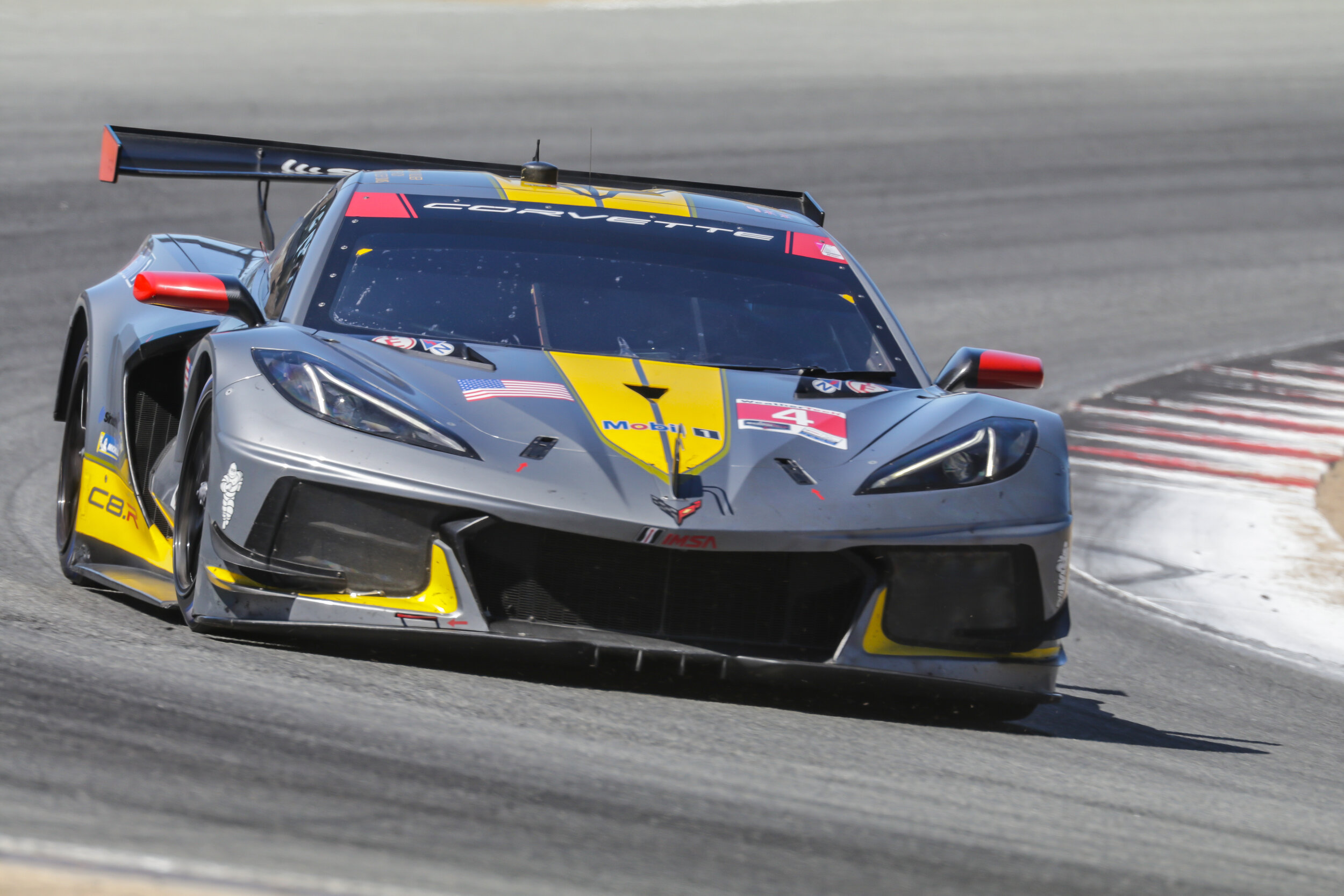Monterey Sports Car Championship

After a blissful and fulfilling trip to Car Week and the Monterey Motorsports Reunion a few weeks ago, it was time to live in the now! No more carburetors, narrow tires or things made of good old-fashioned pig iron. The cars of the IMSA Weathertech SportsCar Championship are at the opposite end of the automotive spectrum from most of the cars of Historics Weekend These cars are all new….very new. Some are modified versions of cars you can drive off a new car lot today, while others are fully bespoke and purpose-built racing machines. To the lay person, the cars at the sharp end of the spear of this series probably more closely resemble a space craft than a "street car.” (and their performance is more spacecraft)
-
Sometimes you don't know you missed something until it returns. That was our feeling going into the Hyundai Monterey Sports Car Championship at WeatherTech Raceway Laguna Seca after missing out on the event in 2020 (THANKS COVID). While the event 2020 did happen it was without spectators and limited to all but a handful of media. This event is also the start of back-to-back racing weekends labeled Monterey Speed Week as the NTT IndyCar Championship will race at WeatherTech Raceway the following weekend.
We love endurance racing. Nothing tests the mettle of a racing driver (or the viewer’s attention span) more than a competition where four classes of amazing cars, amateur and professional drivers, and (relatively) small teams and those backed by major automotive manufacturers take to the track to see who is best able to blend together just enough luck, skill, money and strategy to win in class or take an overall victory.
The grid for the weekend consisted of 26 cars spread across four classes, DPi, LMP3, GTLM and GTD. If you already know what this means you can skip this next part:
Dpi- Daytona Prototype international- The fastest and most technologically advanced sports cars in North America, the Daytona Prototype international (DPi) is specifically designed and engineered for the race track. DPi cars use chassis built to international specifications powered by engines from mainstream automotive manufacturers like Acura, Cadillac and Mazda. In addition, DPi bodywork includes styling cues that align with these engine manufacturers.
LMP2 Le Mans Prototype 2- The Le Mans Prototype 2 (LMP2) is a closed-cockpit car developed by four approved constructors. In addition to the IMSA WeatherTech SportsCar Championship, LMP2 cars are eligible to compete in other global series such as the FIA World Endurance Championship, which includes the prestigious 24 Hours of Le Mans.
GTLM-Utilizing the same technical regulations as the 24 Hours of Le Mans, the GTLM cars are the most elite and fastest GT cars on the track. Based on production models, they are engineered to extract the maximum performance possible. The class serves as a true proving ground for leading manufacturers such as BMW, Corvette, Ferrari and Porsche.
GTD-The GT Daytona cars are enhanced (not defined by) technology and utilize the global FIA-GT3 specification. The GTD class consists of cars from leading manufacturers such as Acura, Audi, BMW, Ferrari, Lamborghini, Lexus, McLaren, Mercedes-AMG, and Porsche.
Past, Present, and Future:
The full grid of 26 cars is down from previous years as the series has seen the departure of teams and manufacturers. For example, in 2018 the grid had 34 total cars in competition. The GTLM category has seen the largest exodus with only three cars in class for most of the 2021 season. Porsche departed to focus on the revised top-tier Le Mans class, LMDh. BMW has stepped back as well leaving Corvette Racing as the only full-time factory supported effort. Much of this reduction of grid size is a combination of costs concerns and pending changes to the rules for future seasons that have led teams and manufacturers to focus on cars for the new categories that will emerge in 2022, specifically the GTD Pro class. IMSA predicts that GTD Pro will see “significant” participation from manufactures at the 60th Rolex 24 at Daytona in 2022.
Does this mean that the weekend was less than…. Not in the least.
Sunday’s race day weather could not have been better around the 11 turns of Laguna Seca Raceway. The Wayne Taylor Racing (WTR) Konica Minolta Acura ARX-05 grabbed pole on Saturday with the efforts of driver Filipe Albuquerque behind the controls. On Sunday, Albuquerque and Ricky Taylor would lead from pole, emerge victories from a fuel strategy battle and finish in first giving WTR they first victory at Laguna Seca since 2013. With only two races remaining in the championship, the Acura Grand Prix of Long Beach and Michelin GT Challenge at VIR Taylor and Albuquerque holds a 100 point lead over their nearest rivals, Felipe Nasr and Pipo Derani in the No. 31 Whelen Engineering Cadillac.



While WTR pulled away and never looked back, the closing laps saw a significant change of position as the No 1 Chip Ganassi Racing Cadillac Dpi-VR piloted by Renger van der Zande caught up with the No. 31 Whelen Engineering Cadillac in the closing laps to take second place.
The fuel strategy game would have an impact and not exactly pan out the way it was intended. Typically, Laguna Seca will see several yellow flags incidents when IMSA is in town but this time around only one yellow came out on Sunday totally throwing off any teams that were counting on caution laps to save fuel. WTR went with a three stop strategy while the Meyer Shank Racing No. 60 Sirius XM/AutoNation Acura would go with a two stop strategy gambling that yellow flags would help them conserve fuel. They yellow flags never arrived. All in all, Taylor Albuquerque taught a clinic on Sunday. We never saw them put a wheel wrong, and it was fantastic to see how well our favorite track could be mastered.
LMP 2
In the opening lap the No. 52 PR1 Mathiasen Motorsports ORECA LMP2 07 piloted by Ben Keating would slip to third, but in only seven laps would regain the lead and would go on to dominate for the win. Not only an impressive win for the No. 52 but also the most impressive livery of any car on the grid. Yes, we will have more of that please!



GTLM
As mentioned before, the GTLM field had only three entries leading to all the action being between the two Corvette Racing entries. Nick Tandy and Tommy Milner would take their first class win of the season taking the lead after their final pitstop. Cooper MacNeil and Matt Campbell brought the Weathertech Racing Porsche 911-RSR-19 in about a second behind the Corvette duo, rounding out the diminutive GTLM class.
GTD:
Bill Auberlen, the winningest driver in IMSA history, led in class for the first hour in the No. 96 Turner Motorsport BMW M6 GT3, but victory slipped away after the first pit stop never to offer a second change. Ultimately, the class win would go to No. 9 Pfaff Motorsports Porsche 911 GT3R piloted by Zach Robichon and Laurens Vanthoor. As is the case in endurance racing, the rest of the entries in this class fought valiantly with each other, while at the same time sharing the track with much faster entries also doing battle within their respective classes. Despite the overall field of cars being somewhat smaller than in past years, it was fantastic to see so many makes taking part in GTD including Lamborghini, Acura, Audi, Porsche and Lexus. There’s something for everyone.
The next stop for the Weathertech Sportscar Championship will be September 24th-25th on the streets of Long Beach, CA. For those lucky enough to be able to attend that race, the IMSA series will be sharing the weekend with the NTT Indycar Series, as the open-wheeled series concludes its 2021 season.
All in all it was quite a show, and a much needed dose of endurance racing we weren’t able to get last year. We’re grateful, as usual, for the opportunity to cover it. As the 2021 season winds down we look forward to the 2022 season, and wait anxiously for all the news of rules changes that will align the IMSA series with the FiA and WEC series. If all goes well the next two years could see an explosion of team participation in all three series that we’re excited to see. The future of endurance racing in American and abroad is indeed bright.
As always, we’ve included a big event gallery below to fill in for any details our words may have failed to describe.
-The Loud Pedal


















































































